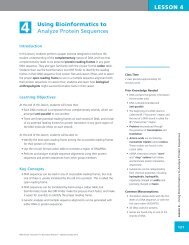WET LAB DNA Barcoding: From Samples to Sequences - Northwest ...
WET LAB DNA Barcoding: From Samples to Sequences - Northwest ...
WET LAB DNA Barcoding: From Samples to Sequences - Northwest ...
You also want an ePaper? Increase the reach of your titles
YUMPU automatically turns print PDFs into web optimized ePapers that Google loves.
<strong>WET</strong> <strong>LAB</strong><br />
Wet Lab: Slide #3<br />
Lysis or “<strong>to</strong> lyse”: To break open.<br />
Proteinase K: Type of enzyme that breaks<br />
down proteins, including nucleases.<br />
Nuclease: Type of enzyme that breaks<br />
down nucleic acids.<br />
5. Show Slide #4, “<strong>DNA</strong> Purification Using ‘Spin Columns,’” which reviews the<br />
steps in <strong>DNA</strong> purification once again, with added visuals and more details<br />
about the labora<strong>to</strong>ry pro<strong>to</strong>col. The materials used are called “spin columns”<br />
because scientists use a microfuge <strong>to</strong> “spin” the <strong>DNA</strong>-binding columns and<br />
speed the <strong>DNA</strong> purification process. Review these steps with students:<br />
a. Day 1: Lyse your sample (break open the cells). This step involves adding<br />
<strong>to</strong> your sample a lysis solution and proteinase K, an enzyme that breaks<br />
down other proteins. This is mixed in nuclease-free water. Nucleasefree<br />
water (such as distilled or nano-pure water) contains no enzymes<br />
(nucleases) that would break down <strong>DNA</strong>. The mixture is then heated<br />
<strong>to</strong> aid the digestion process, as proteinase K activity increases at higher<br />
temperatures.<br />
b. Day 2: Add your sample <strong>to</strong> the spin column <strong>to</strong> bind the <strong>DNA</strong> <strong>to</strong> the membrane.<br />
c. Wash away the cell debris with a wash solution. For this experiment,<br />
students will perform two wash steps – one with a pre-wash solution,<br />
and one with a wash solution.<br />
d. Elute your <strong>DNA</strong> in buffer.<br />
6. Pass out Student Handout—<strong>DNA</strong> Purification for <strong>DNA</strong> <strong>Barcoding</strong> and have<br />
students work through the activity in small groups of up <strong>to</strong> 4 students each.<br />
Enzyme: A type of protein that catalyzes<br />
(increases the rate of) chemical reactions.<br />
For example, ATP synthase is an enzyme<br />
that catalyzes or facilitates the creation<br />
of ATP.<br />
Nuclease-free water: Water that does<br />
not contain nucleases. Often this water<br />
has been subjected <strong>to</strong> multiple rounds<br />
of purification, including being passed<br />
through a nano-filter. It is sometimes<br />
referred <strong>to</strong> as “nano-pure” or “ultra-pure”<br />
water, as it should contain only H 2<br />
O, with<br />
no dissolved salts or other contaminants.<br />
Buffer: A substance used <strong>to</strong> stabilize or<br />
maintain the pH of a solution.<br />
Wet Lab: Slide #4<br />
Wet Lab – <strong>DNA</strong> <strong>Barcoding</strong>: <strong>From</strong> <strong>Samples</strong> <strong>to</strong> <strong>Sequences</strong><br />
327<br />
©<strong>Northwest</strong> Association for Biomedical Research—Updated Oc<strong>to</strong>ber 2012
















